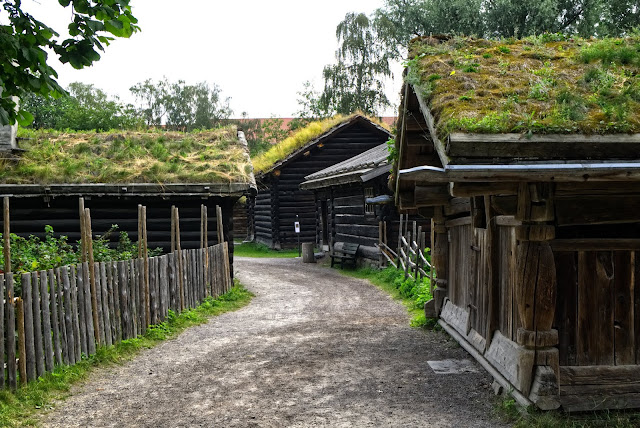Bygdøy is located at the West side of Oslo, which is the capital city of Norway. There are several Norwegian museums here and it is a must go tourist attraction when visiting Oslo to understand the Norwegian culture. Bygdøy can be reached via bus or ferry from Oslo, or people can hop on sight seeing tour bus to get here.
We took the bus from central Oslo to Bygdøy in the morning. The bus took about 30 minutes to get here. The first museum we arrived at is the Norwegian Museum of Cultural History. We actually got here 10 minutes early before it opened to general public. We actually waited a bit until the gate opens up.
This museum was quite unique. It was more like a live demo of what Norway was like at different time such as hundreds of years ago, 1900s, and World War 2 time. There were houses built with wood with sod roof. The sod roof helps to drain water and prevent water leak.
There were also live performance of Norwegian music and folk dance, which was quite interesting. We also visited the traditional Norwegian bakery where they were making the traditional bread by the fireplace. The folks there were wearing traditional Norwegian clothing as well.
At the other part of the museum, it was built with 1900 buildings. It was showing what a normal household look like. There were people demonstrating the traditional Norwegian weaving techniques.
After visiting the Norwegian Museum of Cultural History, we went to visit Viking Ship Museum. Although the museum is just down the street, we still took the bus to there since the we were able to catch the bus as it was arriving. When we got there, there were so man people coming from the tour bus. It was crazy. At Viking Ship Museum, it did not allow large backpack to be carried into the museum and had to be stored at the locker that was free of charge.
The Viking Ship Museum had a full scale real Viking ships. One of the ships was perfectly maintained and it was larger than what I expected. However, the side of the ship was quite low, we were kind of wondering how this kind of ship can sail across the ocean.
The Viking Ship Museum was much smaller and we finished quite fast. We then headed further South to Norwegian Maritime Museum and Fram Museum. In these museums, it illustrated how Norwegian explorers ventured into Arctic and Antarctica. At Fram Museum, there was a large ship in there to allow people to explore the interior of the ship. The only problem was it was quite hot in there.
Afterwards, we then visited Kon-Tiki Museum across from Fram Museum. It was a small museum and we were not quite sure what this was about. There was a ship in there used by a Norwegian explorer and also talked about the adventure on Easter Island. This museum was not as interesting as the other ones.
After visiting all the museums, we initially wanted to take the ferry back to Oslo, but the wait time was too long and the bus was arriving. Thus we took the bus back to Oslo instead. Overall, Bygdøy was quite an interesting experience. We were glad that we did this as the first thing when we got to Norway as it helped us to understand Norwegian culture more.




EmoticonEmoticon